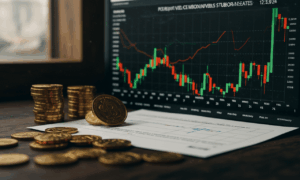The latest PCE inflation report has just been released, and it’s the piece of economic data everyone has been waiting for. If you’ve felt like the conversation around the economy is a constant back-and-forth about whether prices are cooling down or interest rates will ever drop, you’re not alone. This report is a crucial piece of that puzzle. It offers a detailed look at what’s happening with prices and consumer behavior, directly influencing major decisions by the Federal Reserve—the very decisions that impact your wallet, from mortgage rates to the interest you earn on your savings. We’re going to break down exactly what this new data says, why it matters so much, and what it signals for the financial road ahead.
Understanding the Fed’s Favorite Inflation Gauge: What is the PCE?
Before diving into the numbers, let’s clarify what we’re talking about. You’ve likely heard of the Consumer Price Index (CPI), which is often cited in news headlines about inflation. However, the Federal Reserve, the central bank of the United States, has a different preferred metric: the Personal Consumption Expenditures (PCE) price index.
So, what’s the difference, and why does the Fed favor the PCE?
- Scope: The PCE index covers a broader range of goods and services than the CPI. It measures the prices of things people and households buy, including items purchased on their behalf, like employer-provided health insurance.
- Flexibility: The PCE is more dynamic. Its formula allows it to account for substitution. For example, if the price of beef skyrockets and consumers start buying more chicken instead, the PCE index adjusts its weightings to reflect this change in spending habits. The CPI, on the other hand, uses a fixed basket of goods for a longer period.
Because of this broader scope and flexibility, the Fed believes the PCE provides a more comprehensive and accurate picture of the underlying inflation trend in the economy. The specific number they watch most closely is “core PCE,” which excludes the volatile food and energy categories to get a clearer view of the long-term inflation trend.
The April 2024 Numbers: A Story of Stubborn Stability
The new report for April 2024 came in largely as expected by economists, which in today’s uncertain world is a form of good news. There were no alarming surprises, but there also wasn’t the rapid progress on inflation that many were hoping for.
Here are the key data points:
- Core PCE Price Index (Month-over-Month): Increased by 0.2%. This was a slight deceleration from the 0.3% seen in the previous three months and matched expectations. A smaller monthly increase is a positive sign.
- Core PCE Price Index (Year-over-Year): Rose by 2.8%. This figure was unchanged from March and was also in line with forecasts. While it’s a significant drop from the peaks of over 5% we saw previously, it’s still well above the Fed’s 2% target.
- Headline PCE Price Index (Year-over-Year): This measure, which includes food and energy, held steady at 2.7%.
In simple terms, inflation isn’t getting worse, but it’s not getting better very quickly either. It has proven to be quite “sticky,” meaning it’s stubbornly staying higher than the Fed’s goal. This steady, but elevated, data reinforces the central bank’s recent message of patience.

Why This Report Directly Affects Your Finances
This economic data might seem abstract, but its implications ripple through every aspect of personal finance. The Federal Reserve’s primary tool to combat high inflation is raising interest rates. Higher rates make it more expensive to borrow money, which cools down demand and, in theory, brings prices down.
The April PCE report signals that the Fed will likely keep interest rates at their current high levels for longer. Hopes for an interest rate cut in the early summer have all but vanished. Here’s what that means for you:
- Borrowing Costs: Mortgages, car loans, and credit card APRs will remain expensive. If you’re looking to buy a home or a car, the cost of financing will continue to be a significant hurdle.
- Savings Accounts: On the bright side, high interest rates mean better returns on your savings. High-yield savings accounts, money market funds, and Certificates of Deposit (CDs) are offering the best rates in over a decade. This is a great time to make your cash work for you.
- The Job Market: The Fed is trying to cool the economy without tipping it into a recession—a tricky maneuver known as a “soft landing.” High rates for a prolonged period can slow business investment and hiring, which could eventually impact the job market.
A Deeper Look: The Consumer Is Getting Cautious
The PCE report isn’t just about inflation; it also gives us crucial data on personal income and spending. This is where another interesting part of the story emerges.
In April, personal spending rose by only 0.2%, a significant slowdown from the 0.7% (revised) increase in March and below what economists had predicted. After adjusting for inflation, real personal spending actually fell by 0.1%.
This suggests that after a period of splurging, American consumers are finally starting to pull back. They are becoming more discerning with their money, likely due to a combination of high prices, expensive borrowing costs, and dwindling pandemic-era savings. While a slowdown in spending can be concerning for economic growth, it’s actually something the Federal Reserve wants to see. Reduced demand is a key ingredient for bringing inflation back down to its 2% target.
What Lies Ahead? The Path to 2% Inflation
The latest PCE inflation report paints a picture of an economy in transition. The aggressive fight against inflation has worked to bring it down from its peak, but the “last mile” of this journey is proving to be the most difficult. The data provides no compelling reason for the Federal Reserve to cut interest rates soon, nor does it suggest a need for more rate hikes. The central bank is firmly in a wait-and-see mode, looking for several consecutive months of positive inflation data before making a move.
For now, we can expect the current environment of high borrowing costs and high returns on savings to persist. It’s more important than ever to stay informed by following the latest economic news and to manage your budget and financial goals accordingly. The path forward depends on the data that will be released in the coming months, but this report has made one thing clear: patience is the name of the game.
Frequently Asked Questions (FAQ)
What is the main difference between PCE and CPI inflation?
The two main differences are their scope and formula. The PCE (Personal Consumption Expenditures) index covers a broader range of goods and services, including those paid for on behalf of consumers like healthcare. Its formula is also more flexible, adjusting for changes in consumer behavior (like substituting chicken for beef if beef prices rise). The CPI (Consumer Price Index) tracks a fixed basket of goods and services, making it less responsive to these kinds of substitutions. The Federal Reserve prefers the PCE because it is considered a more comprehensive measure of underlying inflation.
Does this steady PCE report mean the Federal Reserve will raise interest rates again?
It is highly unlikely. While the report shows that inflation is still above the Fed’s 2% target, it did not show an unexpected acceleration. The data was largely in line with expectations, confirming that inflation is just being stubborn, not re-igniting. This supports the Fed’s current “wait-and-see” approach, meaning they will likely hold interest rates at their current level for a longer period rather than raising them further. Future rate hikes would only become a possibility if inflation data in the coming months shows a significant and sustained move upward.



